🤓 The 2026 Local Search Ranking Factors are here!! Check out the report!
🤓 The 2026 Local Search Ranking Factors are here!! Check out the report!

🤔💭 “What does a local search marketing strategy look like for my business in the Google Business Profile system?”
This FAQ is vital and foundational and deserves the full answer this guide provides.
In ideating or launching a new business, or starting to market an existing one, there may be no more practical step than defining its model in a Google context.
✍️ Google will understand your business as falling under one of about a dozen different models with three broader groups: address-based, service area, and hybrid.
This guide will help you discover which one your business falls under, and the goals of this activity are to understand:
Google plays a dominant role in local consumer journeys. The search engine results known as local packs, local finders, Google Maps, and Google Business Profiles are in continuous use by potential customers looking to discover nearby brands, products, and services, to contribute to those brands’ reputations, and to make connections with the owners of those brands.
Getting your model firmly nailed down and your profiles fully optimized to be found, chosen, and used by the public is fundamental to creating a strong local search marketing strategy. Read through the following local business model examples to find your own, know the guidelines that apply to you, and discover your marketing opportunities.
Much information in this guide is drawn from the Guidelines for representing your business on Google, which is a resource you should bookmark. Look at the following examples to discover how to see your business model as Google sees it.
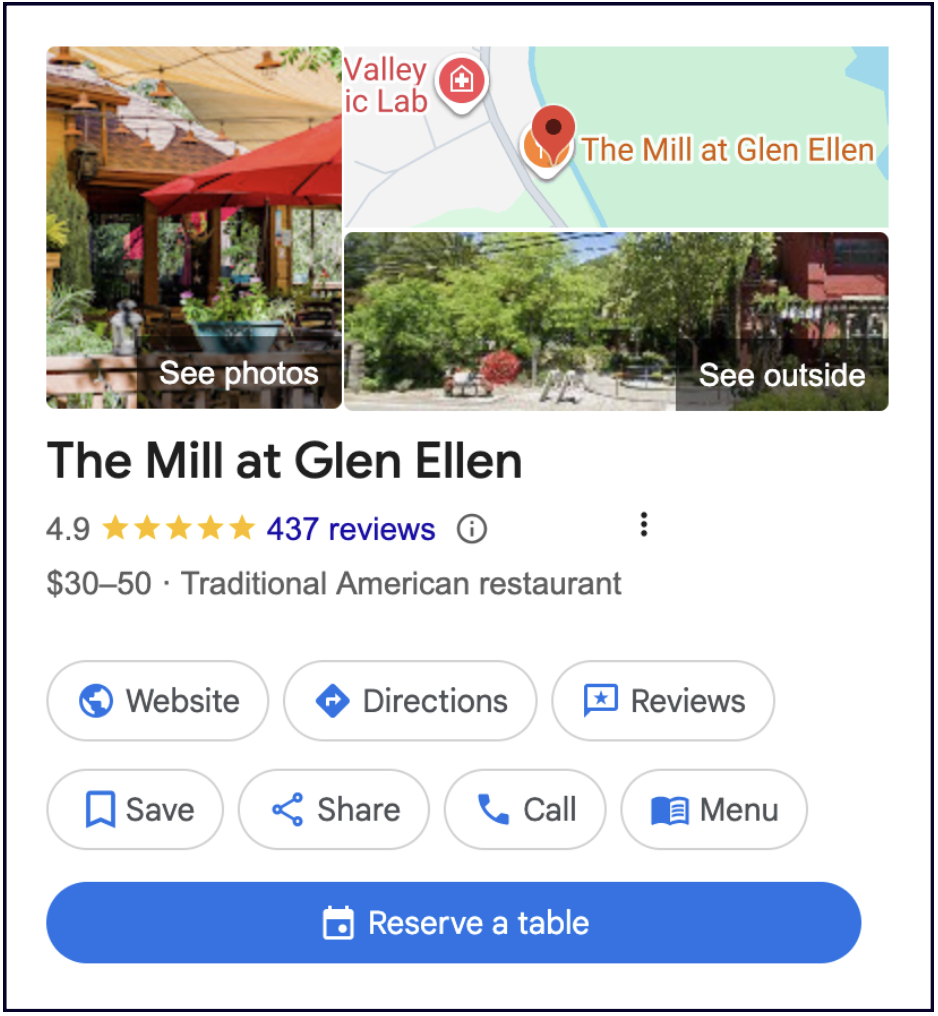
Your business has just one physical storefront to which the public comes to be served face-to-face by your staff. The above example is a single-location restaurant, located at a single street address, and open to the public during stated business hours. Other examples might be a sole-proprietor clothing boutique, an independent local grocery store, or a one-off local plant nursery, instead of chain versions of any of these models.
A single Google Business Profile.
Full use of the Google Business Profile system with no limitations.
❗ There is an exception to this if you are marketing a single location entity categorized as an educational institution. In 2019, Google began disabling the ability for institutions in the category from receiving new reviews on their GBPs, and schools may also be unable to receive user-uploaded photos on their profiles. For an example of this issue see this thread in the Google Business Profile Help Community.
Single location brick-and-mortar businesses should pay special attention to photographing their street level signage and photographing and filming the exterior and interior of their premises. This will help Google trust that the business is legitimate, as well as help patrons locate the business within a town or city.
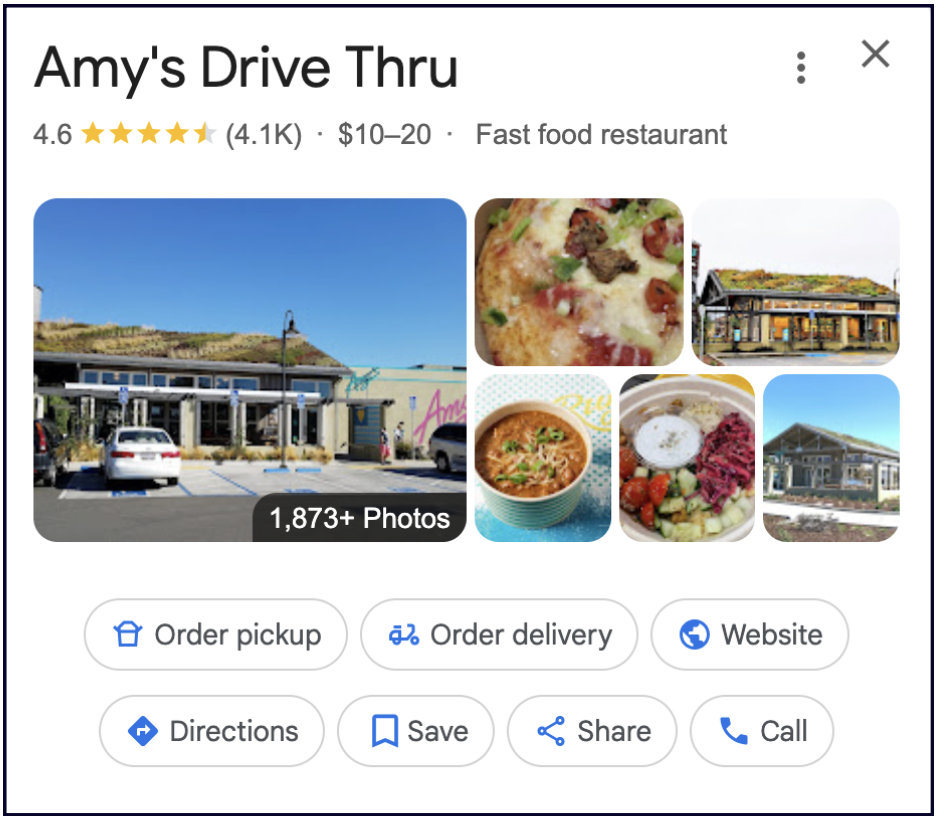
Your business has multiple physical storefronts to which the public come to be served face-to-face by your staff. The above example shows a small restaurant chain with just a handful of locations, but this model can scale to having dozens, hundreds, or thousands of locations open to the public, like major fast food franchises (think McDonald’s) or big brand retail chains (think Target).
A unique Google Business Profile for each of your locations that serve the public face-to-face during stated business hours. You may also be eligible for additional listings if you fall under the multi-department model, which will be covered later in this guide.
Full use of the Google Business Profile system, with no limitations. Multi-location brick-and-mortar brands should pay special attention to setting correct access permissions for each listing. For example, a franchisor will need to carefully think about the level of listing access that will be granted to each franchisee to maintain and market the GBP associated with their location.
In addition to carefully photographing street-level signage and premise interiors and exteriors, multi-location models should be certain that their GBPs’ website fields link to the best destination for potential customers. For example, it creates a better user experience when a searcher clicks on the website link on the GBP for your branch in Ames, Iowa to be taken to a landing page on the company’s website for that store location, rather than being taken to a corporate home page. The development of location landing pages for each branch of the business will typically form a core component of this model’s local search marketing strategy.
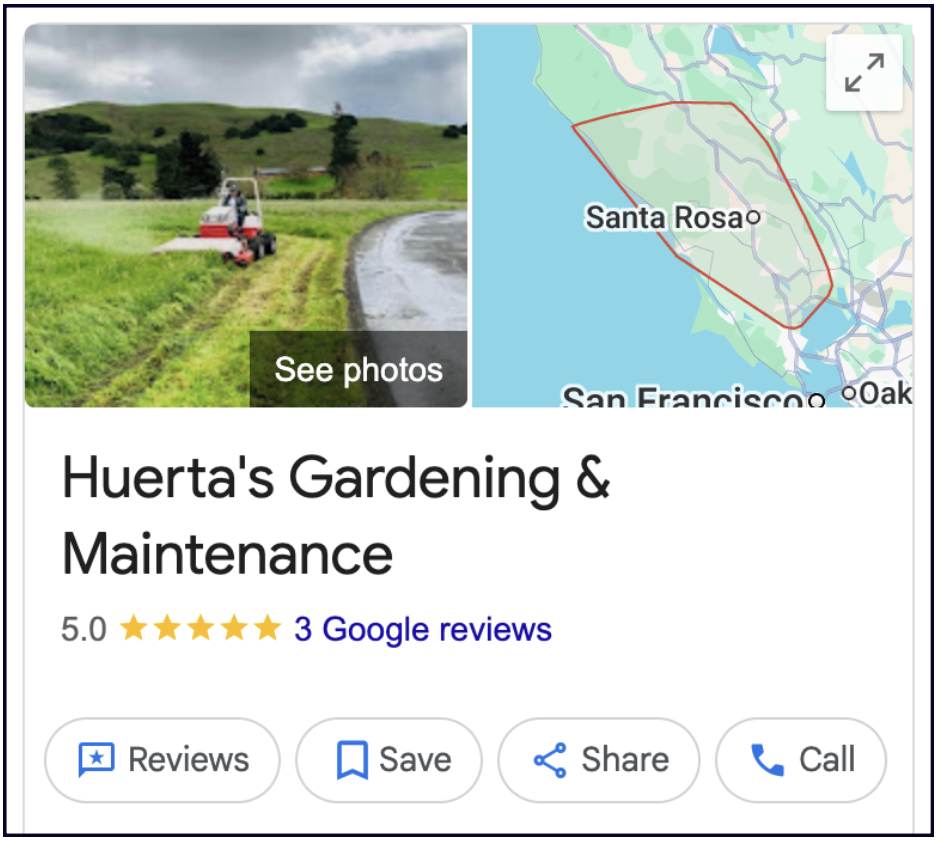
You don’t have a physical location to which customers come, but instead go to customers’ locations to serve them face-to-face. The above example shows a single business that goes to customers’ properties to provide gardening and yard maintenance services. Other examples might be a sole-proprietor plumber, a mobile notary public, or a professional dog walker.
A single Google Business Profile.
❗ You’ll need to have an address when you create your listing (whether that’s your base of operations or even if it’s just your home address) but Google then wants your address to be hidden on your listing. This is their policy for Service Area Businesses (SABs).
Use of all fields of the GBP listing, except address. This can reportedly put SABs at a disadvantage in comparison to their brick-and-mortar counterparts, because there is a documented phenomenon of Google ranking businesses lower when their addresses are hidden. Theories differ as to the cause of this effect, but whatever the root of the problem is, it can feel quite unfair if Google requires SABs to hide their addresses and then punishes them for compliance. This is a topic deserving further exploration.
The only workaround to this scenario is to get an office location for your business (however small) which has visible street signage, is staffed during stated business hours, has a phone which is answered directly by your business during stated business hours, and serves at least some customers face-to-face at the location.
If you can prove all of these things to Google, then you will hopefully be able to display your address on your GBP and enjoy the local search ranking benefits associated with this status.
❗ Do not attempt to use virtual offices or P.O. boxes as they are forbidden by Google’s guidelines.
Your single location SAB should focus on uploading photos and videos that represent your complete service menu. For example, you can document uniformed staff on the job, before-and-after projects, and company vehicles with signage. These assets will do much to signal that you are operating a legitimate business. You should also upload your services to your GBP.
Meanwhile, in multiple business categories, SAB owners must now contend with the paid lead-generation program known as Google’s Local Service Ads. In this program, Google acts as a middleman between you and your customers, and you pay a fee in exchange for leads. If this program is operational in your service area, it is likely you will need to participate in order to be visible to your desired audience. Given this, your SAB brand should do all it can to earn loyal customers outside of Google’s system who are so pleased with your customer service that they come back to you directly for future transactions, instead of going back through Google’s system the next time they need you.
Be sure your website has been optimized to show off your complete service area. Make sure that the service area shown on your website matches what you’ve selected in your Google Business Profile.
✍️ As a rule of thumb, Google wants your GBP service area to extend no further than about two hours’ driving time from your base of operations.
You might create a unique page for each city within your service area, or you might create a single page mapping out your complete service area.
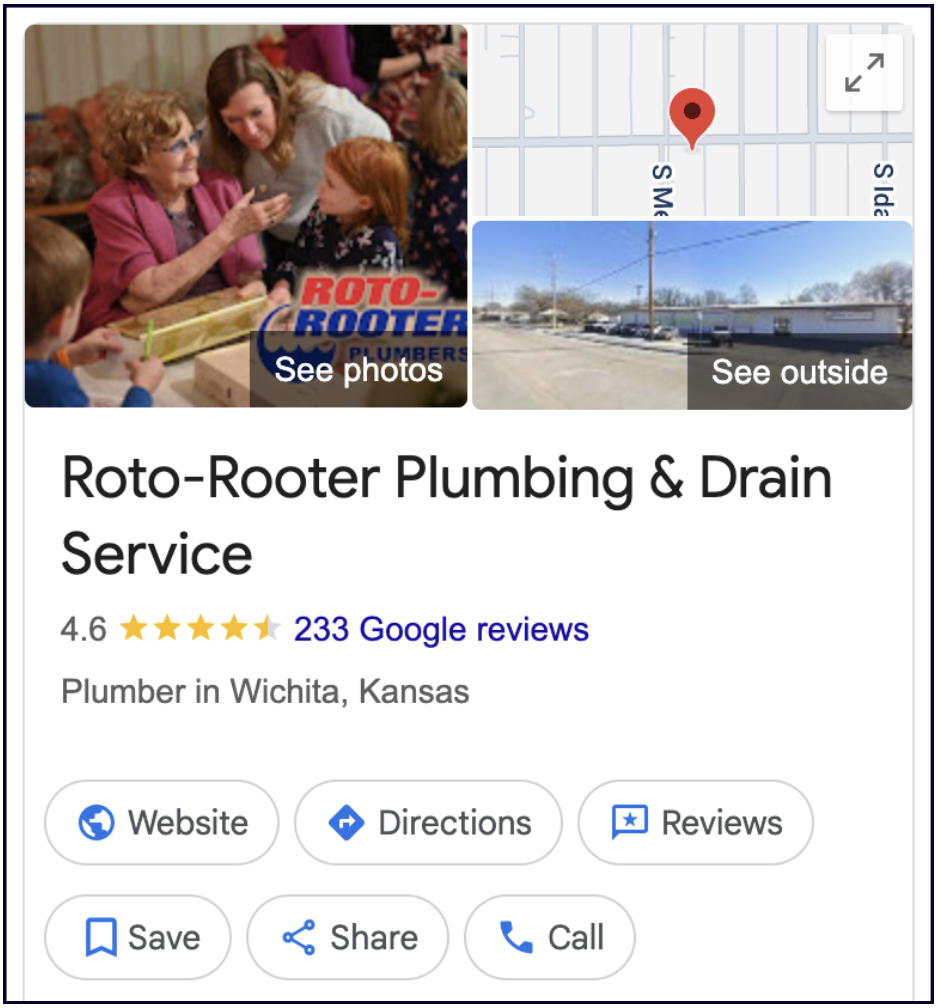
You are serving customers face-to-face at their locations from more than one hub of your business. The above example shows a well-known plumbing chain that offers its services in hundreds of North American communities. Other examples could include large HVAC brands, housekeeping services, or mold remediation businesses with multiple, distinct hubs from which they serve multiple geographies.
A unique Google Business Profile for each location of your business that serves a separate area with separate staff. The boundaries of your GBP’s service area shouldn’t extend further than about 2 hours’ driving time from the base of your business in each community, but Google sometimes makes exceptions to this, allowing large brands to overlap and have GBPs that represent locations that are closer to one another.
You must have a physical address for each SAB location you list (even if it is the home address of the branch manager or franchisee overseeing the service area). Do not use P.O. boxes or virtual offices.
Full use of all GBP fields except the address field, which must be hidden. As with single location SABs, you should pay particular attention to photographing and filming aspects of your business that show staff operating and convey trustworthiness. You will also have to grapple with the positive and negative aspects of Google’s Local Service Ads program if it has been implemented in some or all of your service areas.
Your multi-location SAB should invest in the development of city landing pages or service area landing pages, linked to from your GBPs, that fully describe where and when your services are available to patrons in each community.
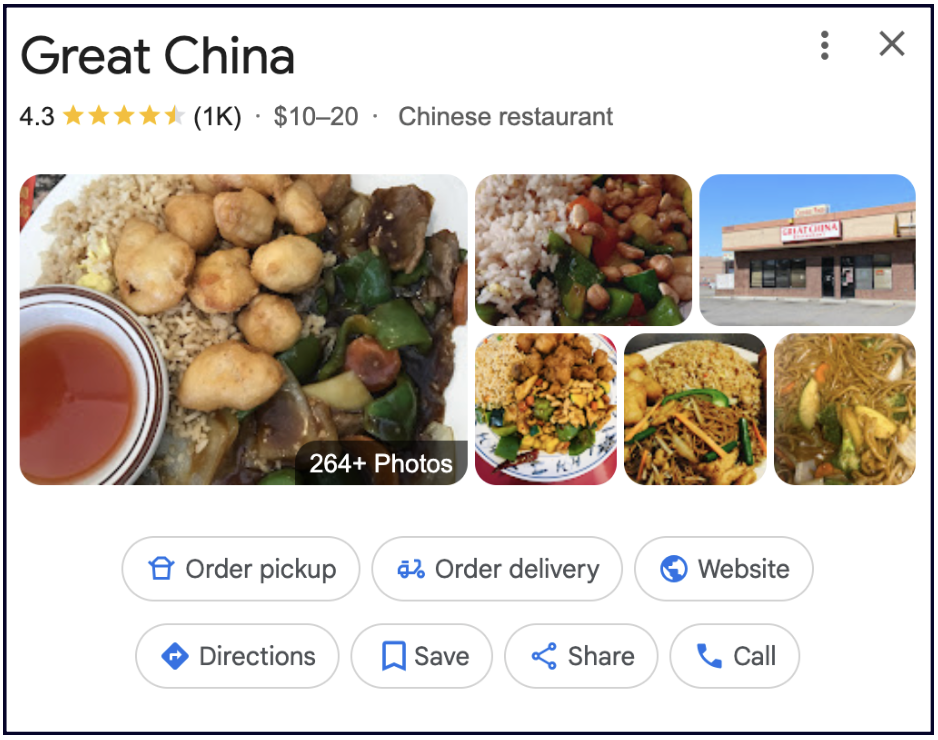
You have a physical location to which customers come, but you also go to customers’ locations to provide some services. The above example shows a sole proprietor Chinese restaurant that offers both indoor dining and home delivery. Other examples of this model might include a locksmith that offers key grinding services at its office but also travels to customers who are locked out of their cars, a pool services company that has a showroom but also does installation on customers’ properties, or an accountant who books appointments at their own office but also visits clients at their premises.
A single Google Business Profile for your single physical location.
Have your address visible on your listing because you serve some customers face-to-face at your location. You are also eligible to designate a service area surrounding your location. Typically, this area should be confined to about two hour’s driving time from your base of operations.
Your hybrid business should carefully film and photograph all aspects of your operations that make it clear that you serve the public both at your location and remotely. Upload your full menu of services to your Google Business Profile, and pay careful attention to any available fields that help you make your model obvious to the public. For example, adding special hours or attributes to your listing can help searchers understand the wide array of ways in which you can serve them.
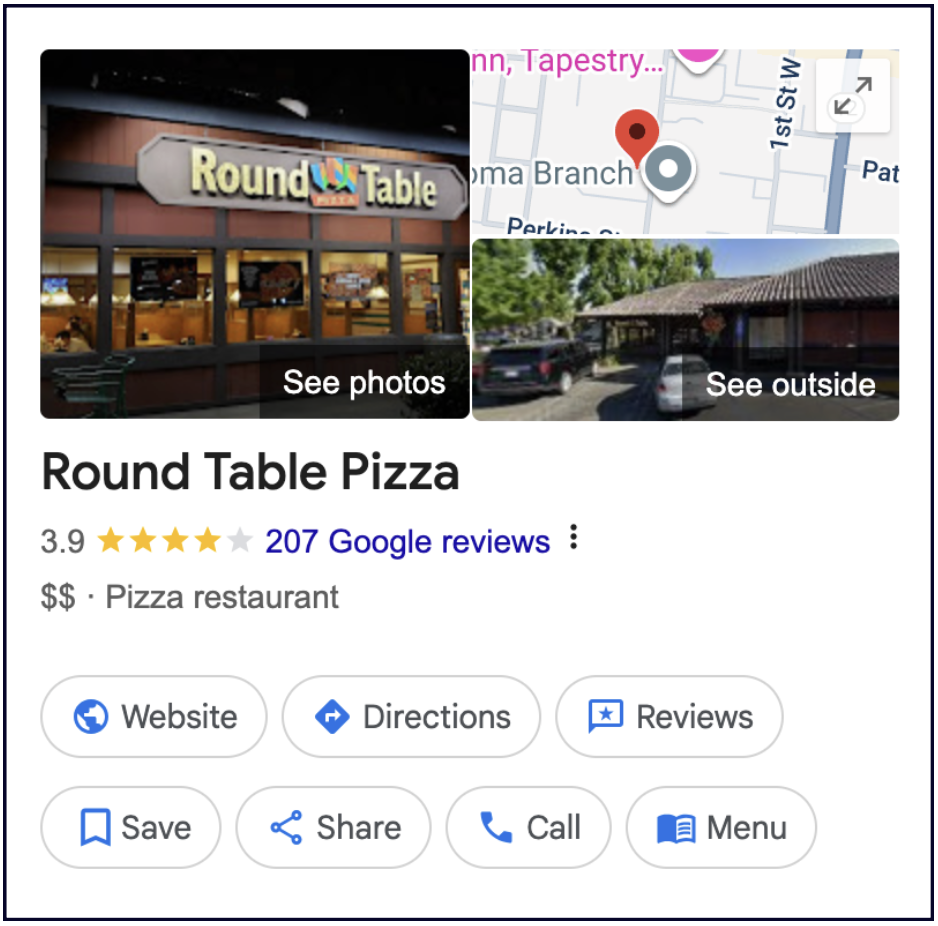
You have multiple physical locations to which customers come as well as multiple service areas. The above example shows a major pizza chain that offers both indoor dining and home delivery via hundreds of US locations. Other examples might include an appliance vendor with multiple showrooms and also home installation services in multiple communities, or a home goods brand with multiple storefronts and an interior design service in which consultants visit clients’ homes.
A single Google Business Profile for each of your physical locations.
Have your address visible on your GBPs because you serve at least some of your customers in person at your locations. You are also eligible to designate a service area surrounding each location. Typically, these service areas should not extend beyond 2 hours’ driving time, and should not overlap, but Google often makes exceptions to this rule for large brands. For example, it’s quite typical for cities to have multiple outlets of the same pizza franchise, and service areas may well overlap.
Your hybrid model should take advantage of all fields available to both brick-and-mortar and SAB brands, and particular care should be taken in designating appropriate listing access to branch managers and franchisees so that they can help drive your marketing strategy on the ground. It’s also vital to create a clear plan for the use of store locator widgets and location landing pages that not only provide information about the services on-site, but also clarify the service area surrounding each branch.
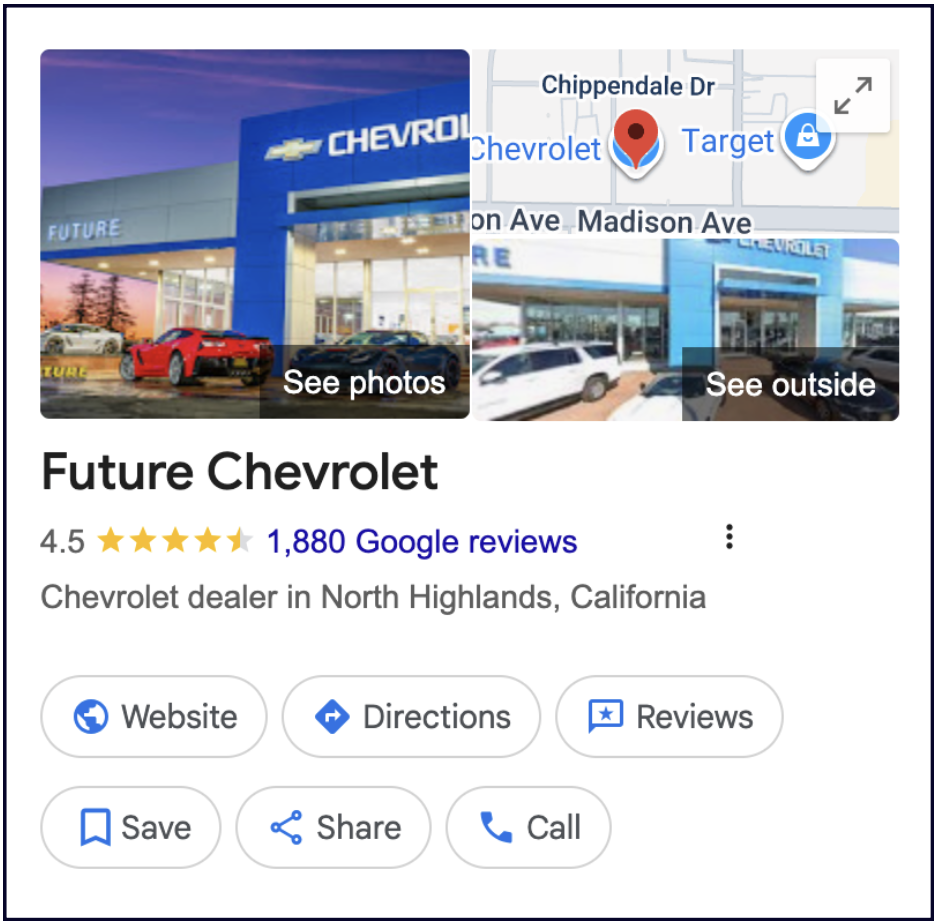
Your business contains multiple public-facing departments, typically with separate phone numbers, and sometimes with separate entrances. The above example shows an auto dealership which has separate departments for sales, parts, and services. Other examples could include a medical center with separate departments for radiology, burns, and family medicine, or an educational institution with an English department, a bookstore, and a campus cafeteria.
A unique GBP for each public-facing department. This applies to whether you have a single location multi-department business (like a single college) or a multi-location, multi-department business (like a major medical provider with dozens or hundreds of locations across a state or country).
Make use of all Google Business Profile fields, with the exceptions relating to reviews and photos applicable to educational institutions referenced above.
💡 Car dealerships could actually be seen as a business model of their own because Google not only allows these entities to create separate listings for each department, but also for each brand of automobile carried by the business (for example, a separate listing for Fords, Chevrolets, and Toyotas). If you are marketing an auto dealership, read Google’s separate guidelines for these models.
The two main FAQs that arise when marketing multi-department businesses relate to GBP naming and categorization. Google understands the confusion surrounding these topics and provides the following guidance:
“Publicly-facing departments that operate as distinct entities should have their own page (Google Business Profile). The exact name of each department must be different from that of the main business and that of other departments. Typically such departments have a separate customer entrance and should each have distinct categories. Their hours may sometimes differ from those of the main business.
For each department, the category that’s the most representative of that department must be different from that of the main business and that of other departments.
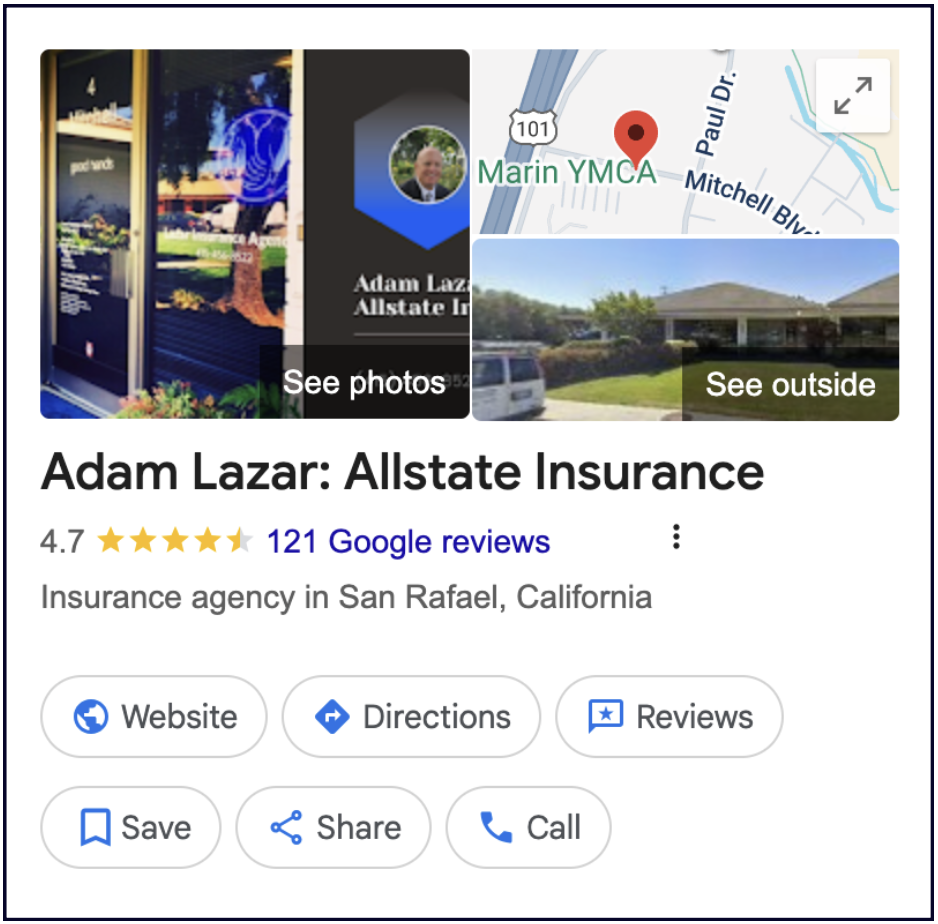
You are the sole public-facing practitioner. The above example shows the sole insurance agent at a location of a branded insurance company. Other examples might include an office with a single dentist, chiropractor, or lawyer. As a public-facing practitioner, you must be directly contactable during listed business hours.
A single Google Business Profile.
Make choices about how to brand your Google Business Profile. If you are a solo practitioner at a sole proprietor business (like being Dr. John Jones of John Jones Dentistry), you will likely want to list yourself as John Jones Dentistry, rather than by your personal name.
However, if you are the solo practitioner at a branded organization (like the above example of Adam Lazar operating as an agent of Allstate Insurance), then Google requests that you follow a specific format that the above listing is not currently compliant with.
❗ Google wants individual practitioners at branded organizations to use the following format:
[brand/company]: [practitioner name]
Thus, the above listing title should read: “Allstate Insurance: Adam Lazar”.
Practitioners serving at their own branded businesses should focus on building up the website content, social media presence, and reputation of their practices, while those working under the umbrella of others’ large brands (like Allstate) should focus on promoting their own names in this way.
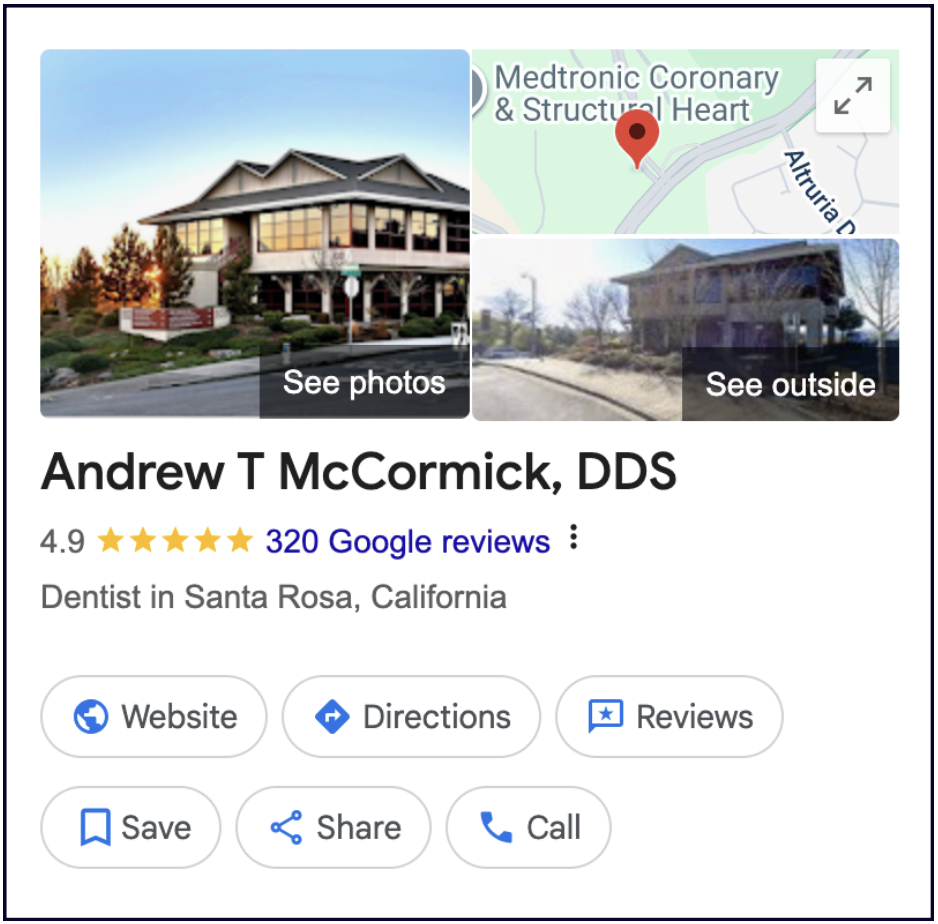
You are a public-facing practitioner at a business with multiple practitioners. The above example shows a dentist at a large practice with many partners. Other examples might include a legal practice with multiple attorneys, or a real estate firm with multiple agents.
Multiple listings. A multi-practitioner business can typically create a single Google Business Profile representing the practice, plus a unique Google Business Profile for each public-facing practitioner who works there.
Market both the practice and the practitioners. However, there are several guidelines to pay attention to. Firstly, multi-practitioner listings should only feature the names of the practitioners – not the names of the practice. The above listing for Dr. McCormick gets this right. Also, be sure the business is only listing public-facing staff in a partnership role. For example, a dental practice should create listings for each of its dentists, but should not create additional listings for something like members of the office staff.
💡 Multi-practitioner businesses can help grow their digital footprint by creating practitioner landing pages on the company’s website. Each page can feature the name, contact information, hours of operation, and biographical information about the individual practitioner, and the Google Business Profile for each partner can be linked to their landing page.
It’s important to know that having multiple practitioners in the same primary category at the same address can result in some ranking challenges. At the automatic zoom level of Maps, Google frequently filters out businesses that share locations and categories. A business can find itself being hidden while one of its practitioners is visible, until users zoom in on the Map.
If you cannot diversify categories across multi-practitioner listings, you may run into this problem and need to minimize the optimization of these listings while maximizing the effort you are putting into the main listing for the practice. It’s best for brands to retain central control over category choices in the multi-practitioner scenario; otherwise, practitioners may decide to change their categories in a way that causes filtering.
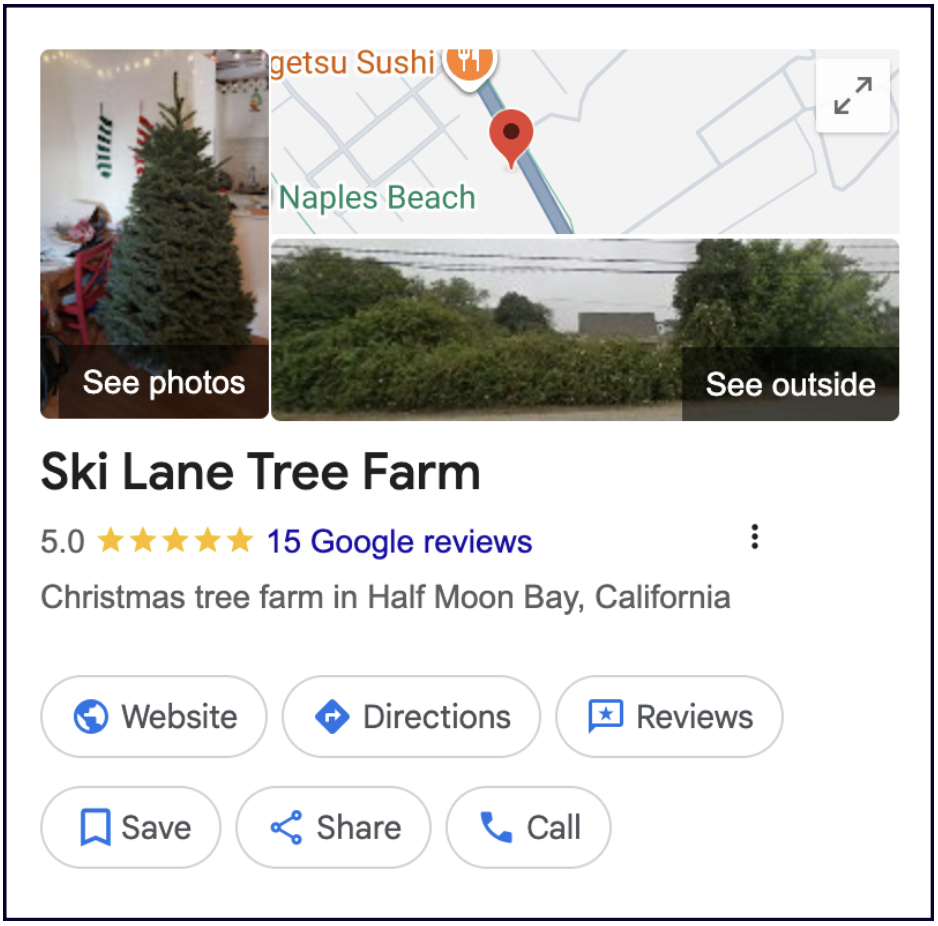
Your business is only open at a specific season and closed to the public for the remainder of the year. The above example shows a Christmas tree farm, and other examples might include a summer farmstand, an autumn pumpkin patch, or a holiday ornament store.
A single Google Business Profile, provided that you have street-level signage and a street address.
Manage your Google Business Profile hours so that the public knows when you are open or closed for the season. Google offers the following guidance:
It’s also permissible for you to have multiple listings if you operate multiple, distinct seasonal businesses at your location. For example, if your location features Grandpa’s Pumpkin Patch in September and October, but Shining Star Christmas Tree Farm then opens in November on the same property, you can get a different phone number, build a different website and marketing strategy, and create a different GBP for each business, provided you properly manage their seasonal hours, as described above.
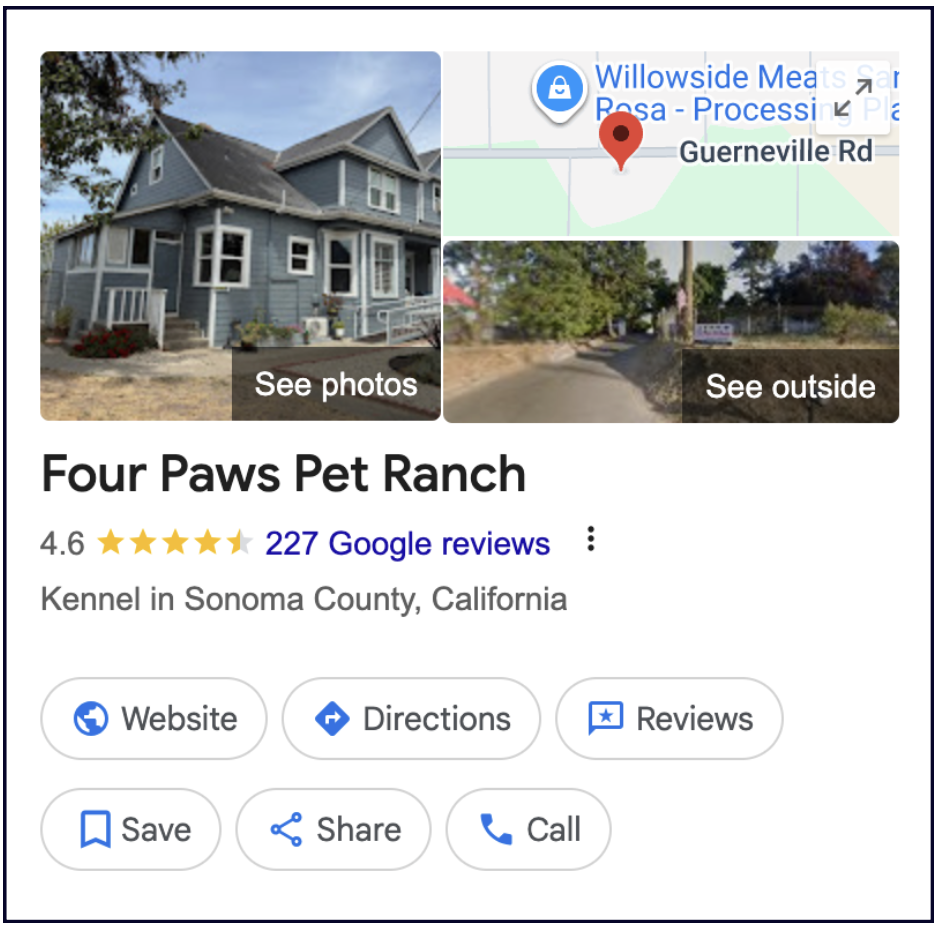
You serve the public face-to-face, either at your home or at their locations from an operation that exists within your home. The above example shows a pet boarding and grooming business operating out of an individual’s home. Other examples might include a bookkeeper with a home office, a home-based daycare center, or a home-based tree trimming service.
A single GBP. You will need to provide your address to Google, but if you do not want it displayed publicly, you can list yourself as a service area business to reflect that you serve customers at their locations instead of at yours.
There are some instances in which a home-based business owner is operating more than one enterprise from their house. You may be eligible for more than one Google Business Profile if each of these entities has its own distinct name, phone number, website, and Google business category and can prove to Google via official business documentation that you’re trying to list a legitimate entity.
For example, the person operating a dog grooming business called Pampered Pets could have a listing for this business while having a separate listing for their landscaping services company, Green Tree Landscaping.
❗ What you want to avoid is building out multiple listings for the different services of any single business. For example, you should not create separate listings for heater repair and air conditioning installation if these all occur under the auspices of your HVAC business.
Market yourself just like standard brick-and-mortar or service area businesses, with the understanding that hiding your address may negatively impact your ability to compete strongly with brick-and-mortar brands whose address is visible in Google’s local search engine rankings.
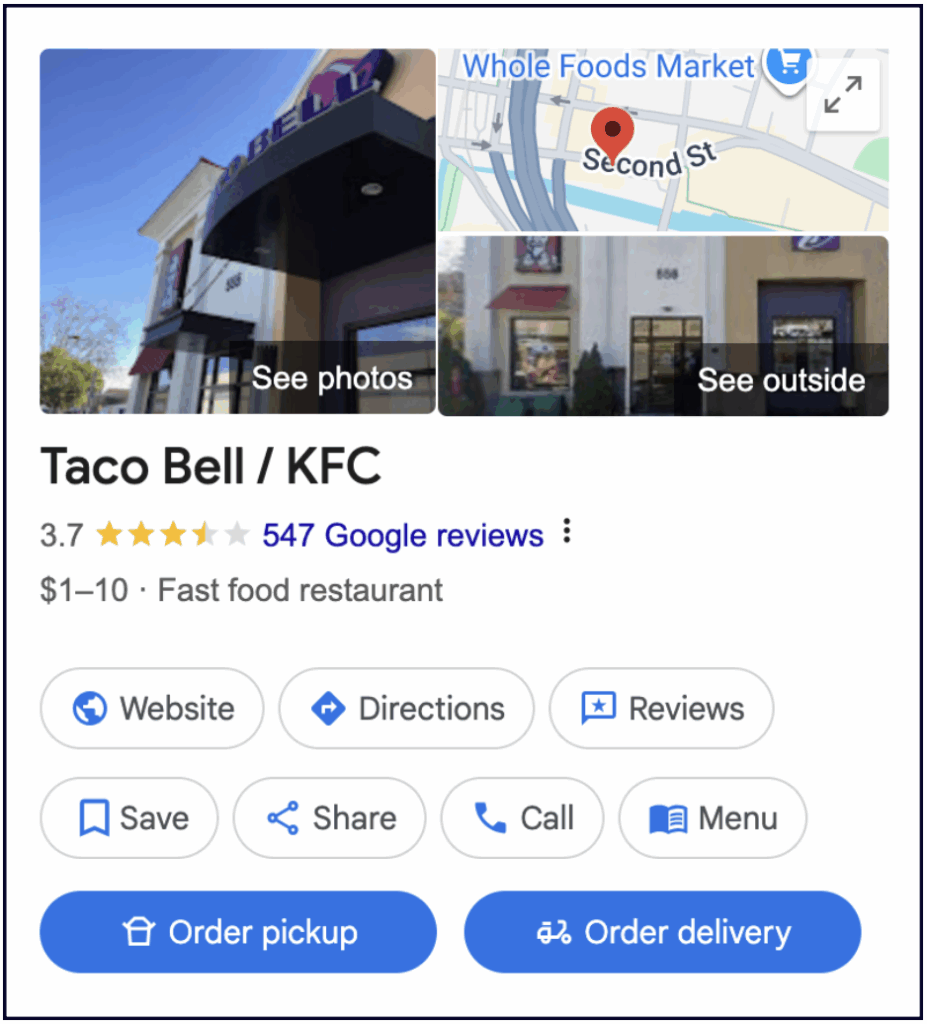
You are either marketing two major brands that share a location, or you are marketing a brand that is contained within a larger entity. In the above example, we see a Taco Bell and KFC that are co-located. An example of an authorized reseller would be a tire store that is authorized to vend a major tire brand like Firestone.
A Google Business Profile for each distinct entity, provided you follow the guidelines explained below. Note that the above screenshot of the co-located KFC+Taco Bell is getting it wrong and needs to change their business title to comply with the guidelines.
Create GBPs that adhere to the relevant guidelines, including the following:
If your business location combines two or more brands, do not combine the brand names into a single Business Profile. Instead, pick one brand’s name for the Business Profile. If the brands operate independently, you may use a separate profile for each brand at this location.
For multiple virtual food brands at the same location, refer to the food-specific guidelines in the Virtual food brands section below.
If your business sells another business brand’s product(s) or service(s), use only the name of the business, excluding the name of the brand being sold, which can’t have a Business Profile for this location.
However, if the business is an authorized and fully dedicated seller of the branded product or service, sometimes known as a “franchisee”, you may use the underlying brand name when you create the Business Profile.
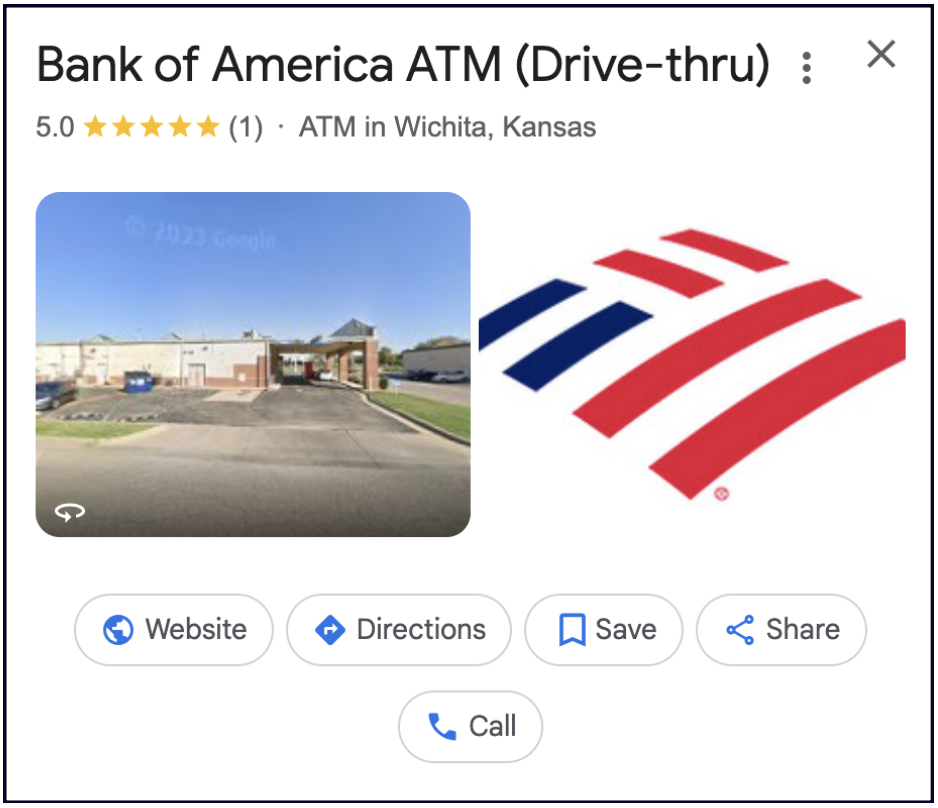
In addition to the standard business models covered above, you may be marketing a business that falls outside any of the above models yet may still be eligible for a Google Business Profile. Here are some common examples of this:
ATMs are eligible for their own listings, provided the machines display a number customers can call for assistance if something goes wrong.
Kiosks such as vending machines, photo booths, or DVD rental units are eligible for their own listings, provided they have a permanent location, feature a customer service phone number on the kiosk, use a different phone number than the store that contains them if they are contained inside a business, and list accurate hours that reflect when the kiosk is accessible if inside another business.
If the kiosk is located outdoors and is publicly-accessible at all times, it can be listed as a 24-hour operation. If a company operates multiple kiosks, its website should have a store locator widget which displays all locations.
Virtual kitchens feature their own extensive guidelines in Google’s documentation, including the following:
Virtual food brands are permitted with conditions.
Co-located food brands offering pick-up
Delivery-only food brands
Food Truck marketers have to make a decision about how to market themselves in Google’s system. They can create a Google Business Profile as if they were a Service Area Business, hiding their address, which will mean they do not have a pin on the map. Alternatively, if they want to prioritize their location being visible, they can add the business to Google Maps instead of to GBP via this process. This means that their location will be visible on Maps, but they will have to make any edits to it via the “Suggest an edit” link instead of via the New Merchant Experience/GBP dashboard.
Rental properties and real estate developments should not list each address that is being offered for rent or for sale, but rather, should list the office at which someone like the apartment building manager or the housing development developer can be directly contacted.
Restricted business categories need to know that Google provides specific guidance for them, including the information that, “Businesses associated with products or services that require the customer to be a certain minimum age, like alcohol, cannabis, or weapons, aren’t permitted as service-area businesses without a storefront.”
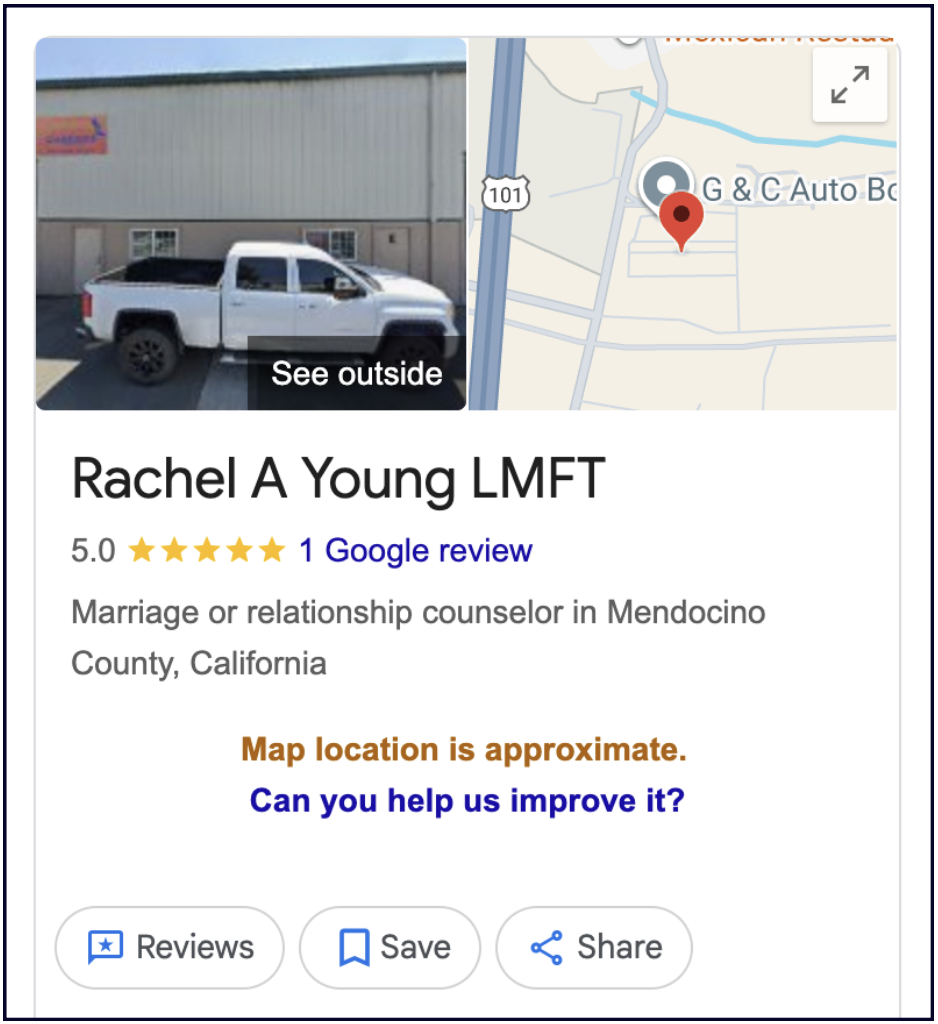
Typically, if your business serves customers virtually instead of face-to-face, it is automatically ineligible for a Google Business Profile. For example, an e-commerce company that ships goods to its customers but never serves them in person should not attempt to market itself via the GBP system.
However, there are some potential exceptions to this long-standing requirement of serving customers face-to-face. For example, the COVID-19 pandemic caused countless brands and practitioners to adapt to partly or fully virtual fulfillment. Doctors, marriage counselors, and many kinds of consultants began helping clientele over the phone or internet. Some practitioners continue with this model today, due to ongoing contagion risks or because of the reduced overhead costs it provides.
Unfortunately, Google has not publicly addressed this reality with special guidelines. Therefore, if you are marketing something like a marriage counselor who now sees all of their clients via telemeetings, you can experiment with listing them as a service area business/home-based business, but could encounter a listing suspension if Google questions the legitimacy of the operation.
Having proofs like Permanent signage on your door and plenty of documentation such as licenses and bills could help you convince Google to consider reinstating your listing in such a case, but consider this experimental ground.
E-commerce businesses that serve all customers virtually typically are not eligible for GBPs because they lack the model of face-to-face service.
An exception to this would be e-commerce brands that have physical headquarters to which some B2B customers come for large order fulfillment. An example of this might be the staffed office of a manufacturer that sells the majority of its products online, but may also have some offline relationships with large clients who need to come to the office for product demos and transactions, and therefore, need to know where the business is located. Google’s guidelines could go further to address this type of business model.
If you see customers face-to-face, and have a legitimate street address of some kind, you are typically eligible to market your business within the Google Business Profile system. However, it is vital to follow the guidelines Google has laid out to avoid negative outcomes like having your listings become unverified, disabled, or suspended.
Though Google has not written guidelines for every possible business model, most common operations will find that there are documented dos and don’ts for their scenario. The more complex your model, the more you will need to budget time and money towards managing your Google Business Profiles as well as your listings across a variety of local business indexes. These listings play a vital role in potential customers finding and choosing your business, and they are worth every ounce of effort!
Miriam Ellis is a local SEO columnist and consultant. She has been cited as one of the top five most prolific women writers in the SEO industry. Miriam is also an award-winning fine artist and her work can be seen at MiriamEllis.com.
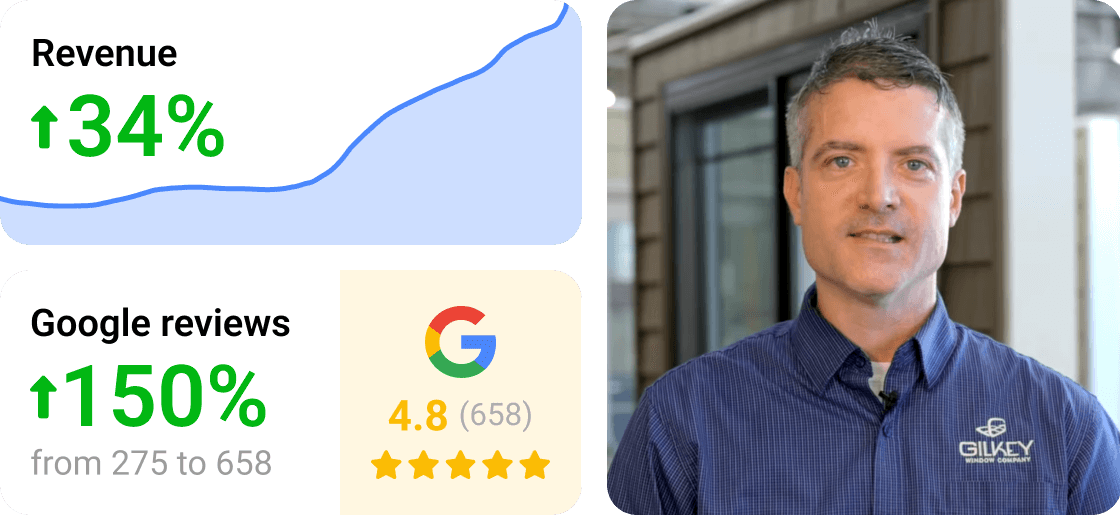

Whitespark provides powerful software and expert services to help businesses and agencies drive more leads through local search.
Founded in 2005 in Edmonton, Alberta, Canada, we initially offered web design and SEO services to local businesses. While we still work closely with many clients locally, we have successfully grown over the past 20 years to support over 100,000 enterprises, agencies, and small businesses globally with our cutting-edge software and services.